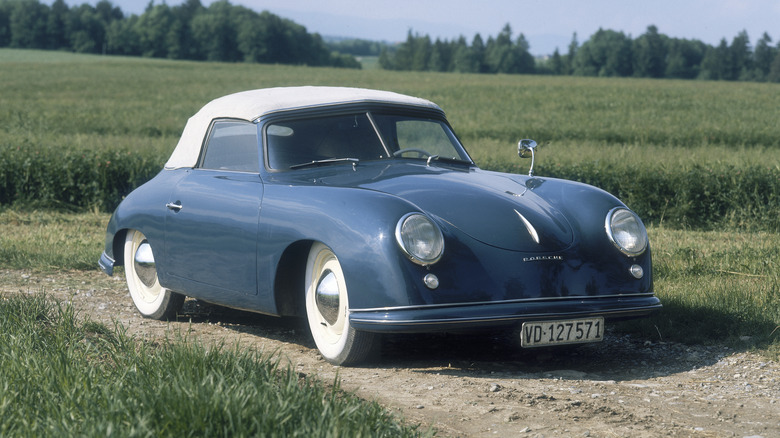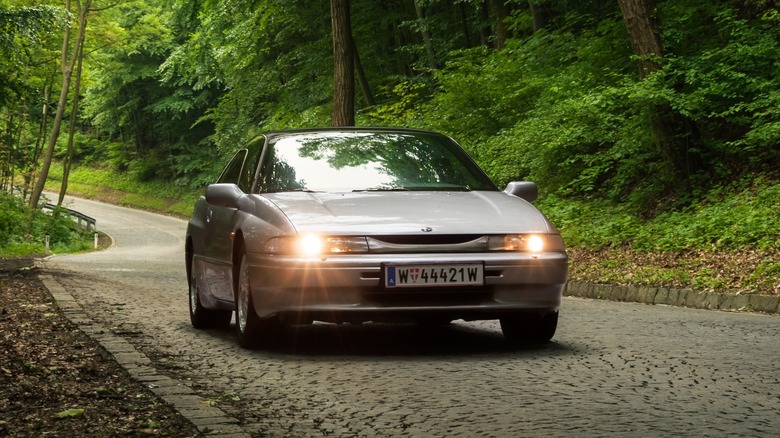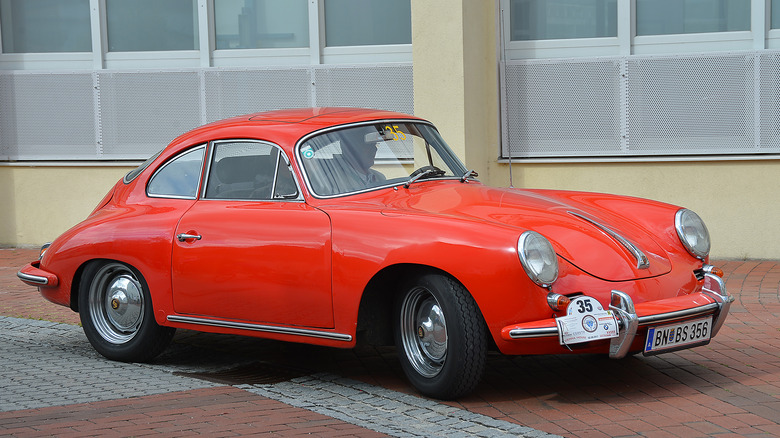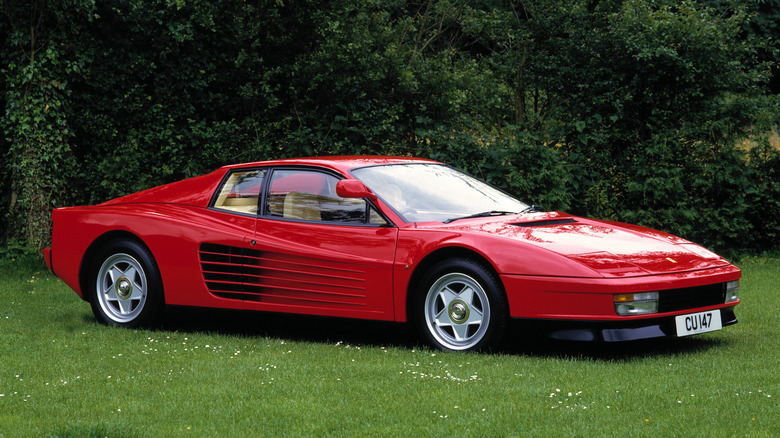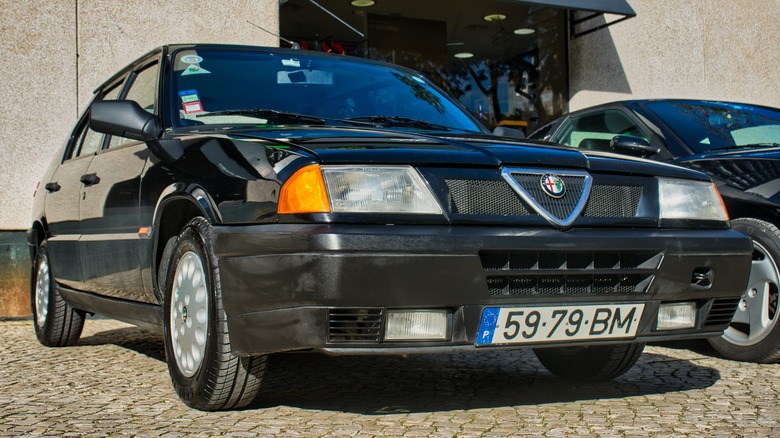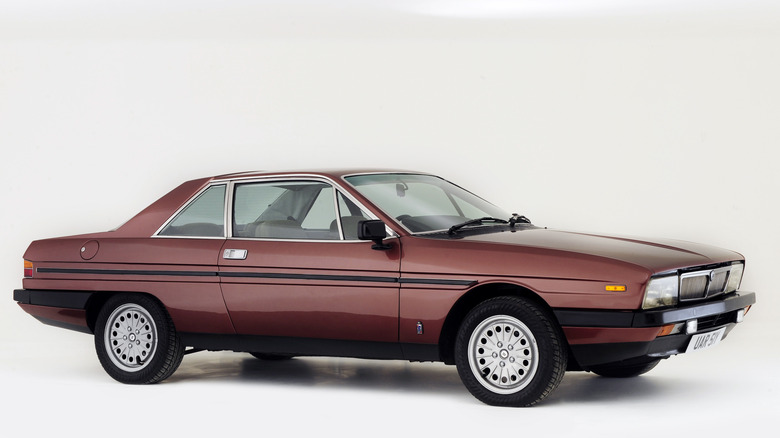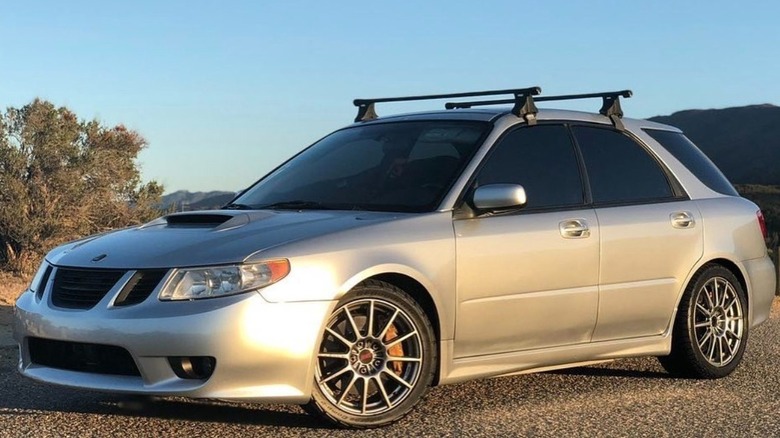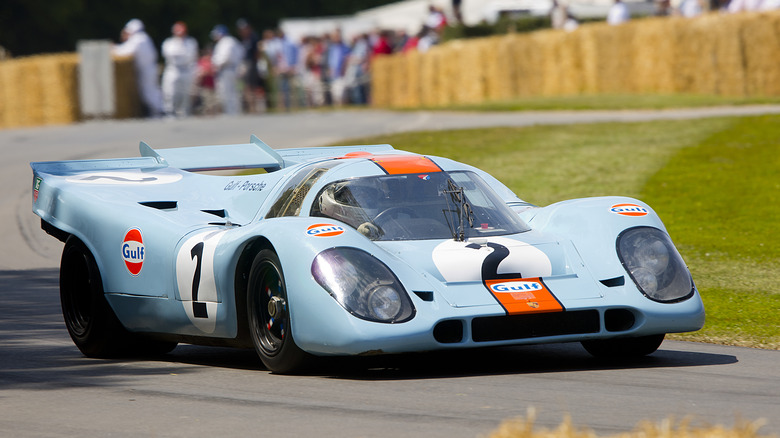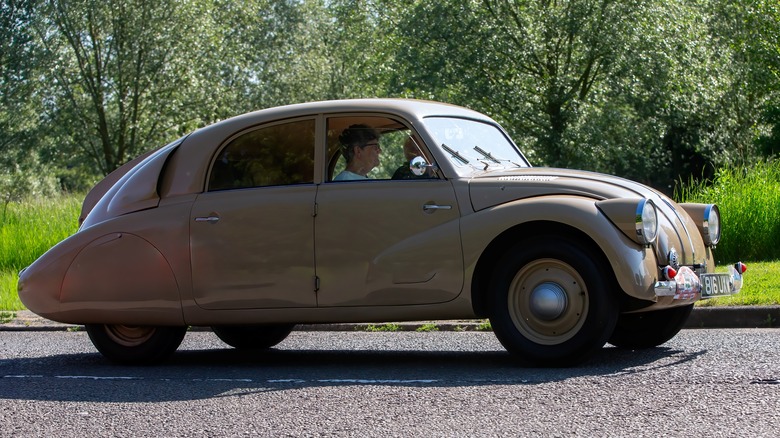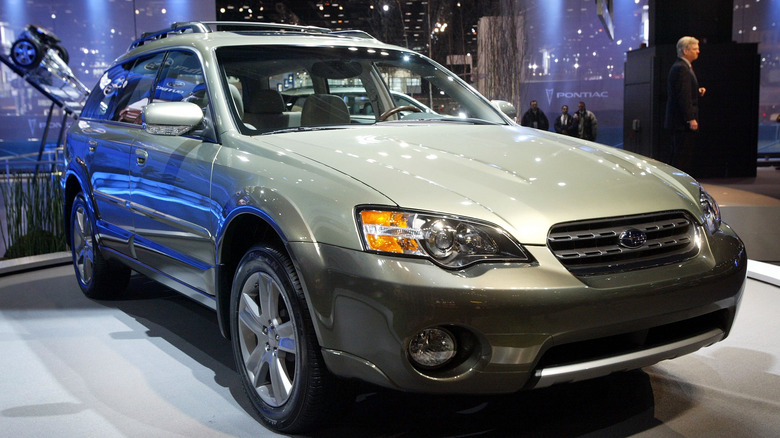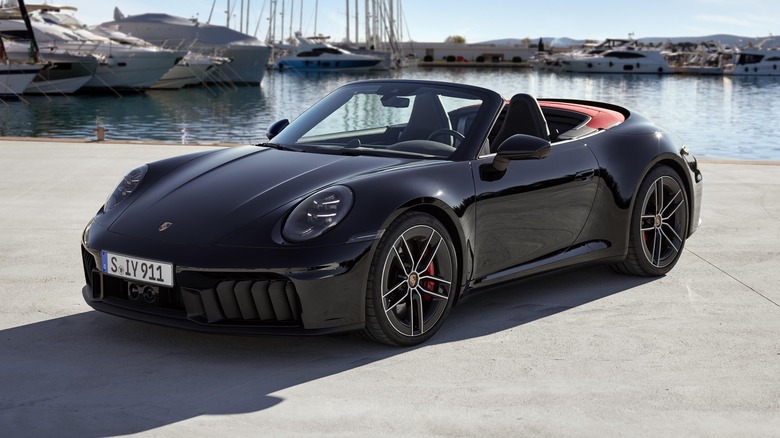10 Of The Coolest Cars With Boxer Engines
We all know how an automotive piston engine works. During the process of internal combustion, the pistons move up and down in either two or four strokes. Almost every car out there uses a conventional piston engine, and although they're all different, the process remains mostly the same across the board.
But what happens when a piston engine is turned 90 degrees sideways? That results in the flat engine, or as it's also colloquially known, the boxer. It works the same way, but it's laid sideways in the engine bay and the pistons look like they're throwing punches at one another, hence the name. This type of powertrain was popularized by Subaru, contributing to the history of the Subaru box engine, but other automakers have used it as well.
A boxer engine brings along quite a few benefits compared to a regular, vertical piston engine. Some of the most notable ones are safety, as the engine is mounted really low down under the hood. It's also perfectly balanced, and it lowers the center of gravity of the car, giving it even better dynamic capabilities. This fascinating type of engine is very uncommon nowadays, but over the past few decades, we have seen some very cool cars with boxer engines that are worthy of appreciation.
Subaru SVX
During the Japanese economy boom in the late '80s and early '90s, most of the major Japanese automakers had a flagship sports car that still elicits intense reactions from car enthusiasts. The Mitsubishi GTO and the Honda NSX, both of which were way ahead of their time, were part of this group. Subaru wanted a piece of the action, joining its competitors with the Alcyone SVX, also called just the SVX.
To this day, the SVX remains one of the bravest exercises in automotive styling. The striking greenhouse area, the slender bodywork, it's all very '90s and very captivating. Being a Subaru, power could only come from a boxer engine.
The SVX used a 3.3-liter flat six, putting out a respectable 230 hp and 228 lb-ft of torque. Admittedly less than the "276 hp" of the competition, but still a good amount of shove. Subaru's big mistake with the SVX was marketing it more as a GT car, evidenced especially by the fact that only an automatic transmission was offered. Buyers ended up flocking to the competition, and the SVX absolutely tanked on the market.
Porsche 356
While the 911 is the peak of Porsche's lineup (we're getting there, don't worry), most people forget Porsche's ground zero. The 356 was Stuttgart's first proper sports car, and it represents a fantastic example of making use of what you already have. It was also, definitely, the classic Porsche that remains a timeless work of art.
Underneath the bespoke bodywork, the 356 was based on the classic Volkswagen Beetle. The Beetle was already rear-engined and RWD, and after some fettling from Porsche in every aspect, along with the new bodywork, the 356 was born.
Power came from a variety of boxer four engines, most displacing 1.6 liters, though a 2.0-liter was also available. The 356 formed the basis of what eventually put Porsche on the map, the 911. It's part of the reason why 911 haters call it a Beetle, even though the 356 had much more in common with the Bug, and why it's so easy to put together a replica with a Beetle as a donor car. For those who know, the 356 is the stuff of legend.
Ferrari Testarossa
If you listen very carefully, you can hear the impending jokes about Miami, disco balls, and illegal substances. Along with the Lamborghini Countach, the Ferrari Testarossa has become a global icon of the 1980s.
This was Ferrari's flagship 12-cylinder supercar throughout the mid-'80s, first introduced at the Paris Motor Show in 1984. The Testarossa would live on into the '90s across two different evolutions, the 512 TR and the rather unfortunately styled F512 M, with the latter being the last-ever Ferrari to use this specific powertrain.
While we're on the subject, notice how we didn't say V12? That's because the Testarossa was one of the last Ferrari models to use the automaker's boxer 12, first appearing in the Berlinetta Boxer in the '70s. It displaced 4.9 liters in the Testarossa, putting out a punchy 385 hp and 361 lb-ft of torque. Acceleration from 0 to 60 mph was around five seconds, and while there are now hot hatchbacks that will outrun that, this was serious stuff back in the '80s. The Testarossa remains, to this day, one of the most underrated Ferraris.
Alfa Romeo 33
The 1980s were a pretty experimental era for Alfa Romeo. The Italian automaker was still making RWD cars during this time, but its compact FWD model was quite interesting. The 33 arrived in 1983, replacing the ageing and problematic Alfasud, and sharing a name with the incredible endurance race-winning race car. The 33 was still FWD and shared a lot of its components with the Alfasud, but it promised to fix all of the major issues.
The powertrains on the 33 were perhaps the most interesting. Every one of the gasoline units was a boxer, and the diesel was a three-cylinder, about 40 years before that became a cool thing to do. The boxer units also meant a very low hood line, pretty characteristic of some Italian cars of the same vintage.
A 1.3-liter and a 1.5-liter boxer four were available initially, and the latter eventually received a turbocharger for the Quadrifoglio Verde model, bumping power up to 105 hp. Not much nowadays, but serious power back in the mid-1980s. AWD was also eventually offered, so let's all agree that this was Italy's WRX before the WRX even became a thing.
Lancia Gamma
That's the third '70s/'80s Italian car in a row we've had here. The Italians really had a thing for boxer engines during this time, it seems. The Lancia Gamma, often considered to be one of the best-looking mid-size cars of all time, arrived in 1976 as a conventional sedan and a coupe. The gracious design was the work of Pininfarina, which also assembled the coupe version at its own facility.
Power came from either a 2.0-liter or a 2.5-liter boxer four-cylinder, once again explaining the Gamma's very recognizable low hood line. Early versions had carburetors, but at the turn of the decade, fuel injection was introduced.
The Gamma remains one of the most beloved Lancia models to this day, but it wasn't without problems. As well as all the usual gremlins that often plague Italian cars, the Gamma specifically had the infamous steering issue. Lancia's engineers thought it would be a good idea to drive the power steering pump off the camshaft rather than the crankshaft pulley like every other car. If the car hadn't warmed up, and you started it with the steering at full lock, you could nuke the camshaft and/or timing belt, resulting in a very expensive repair.
Saab 9-2X
This one has a very strong cult following, and it's one that brings lovers of Swedish cars and people who use electronic smoking devices together. General Motors loves a badge engineering job here and there, and a controlling stake in what was once Fuji Heavy Industries also opened the floodgates for GM to have a few Subarus as well.
Obviously, the Saab 9-2X was the most notable of the short-lived partnership between Detroit and Shibuya. At its core, the Saabaru, as it's affectionately referred to, is a Subaru WRX wagon, but with a whole lot of Saab thrown into it.
A completely new front end and rear end, unique alloy wheel designs, updated interior bits, and Saab badging round off the 9-2X's different, but familiar look. Power came from a 2.0-liter turbocharged boxer making 227 hp. Because it's an EJ motor, owners have managed to extract a lot more power from it, probably at the cost of a head gasket or two. AWD and a five-speed manual were standard, as you'd expect, and Saab also made a handful of changes to make the 9-2X more dignified, but also handle a lot better. Today, it's a curiosity that deserves more attention.
Porsche 917
In terms of legends that dominated Le Mans, the Porsche 917 is up there with the Ford GT40 as one of the all-time greats. Like the GT40, the 917 also has an incredible story that is a textbook example of the unrelenting desire to win.
The 917 came about as a response to the new Le Mans regulations that the FIA imposed in 1968, requiring all participants to reduce the size of the engines in their prototypes. Replacing the 908, the 917 joined the Le Mans grid at the end of the decade, with one end goal: win the overall championship. Porsche had achieved various pole positions, but never an outright win.
So much work and so much money went into the 917, and Porsche was so confident in its abilities that the boss actually put the entire company on the line. Porsche would take home the title in 1970 and 1971, winning its own bet. The 917 was powered by an air-cooled flat 12 engine, which displaced 4.5 liters in the shorter K version. A car that could reach 60 mph in two seconds and change in the late '60s and early '70s was something unheard of.
Tatra T97
Although we make fun of Eastern European cars for their somewhat low quality and reliability issues, there was almost a guarantee that at least one manufacturer was making something interesting and highly innovative. That was certainly the case with Tatra.
Built in Czechoslovakia, the Tatra T97 was the proof of an experiment involving something that not many other automakers at the time were really bothered with: aerodynamics. By most counts, the T97 is just a mid-size family car, but its aerodynamic shape inspired by and partially designed by a Zeppelin engineer is a real spectacle, even to this day.
This aerodynamic shape attracted a keen interest of a certain Dr. Ferdinand Porsche, and eventually the T97's design was outright copied to create what eventually became the Volkswagen Beetle. Tatra tried to sue, but WWII made that lawsuit frivolous. Like the Beetle, the 97 also used a flat four engine that lived in the rear. Whenever you see a classic VW Beetle, just remember the Tatra T97 was ground zero.
Subaru Outback 3.6R
The Subaru Outback is one of the most lovable oddball automobiles out there. It's often credited with creating the lifted wagon, combining the best elements of wagons and SUVs. With increased ground clearance, a toughened body, and standard AWD, the Outback wasn't the first lifted wagon, but it's now what most people associate with the term.
As expected, the Outback's powertrain lineup was comprised entirely of boxer engines. The earliest models had only four cylinders, but as the Outback evolved, Subaru decided that it would offer Outback buyers its flagship powertrain: the 3.6-liter flat six.
Also seen in the Legacy and the ill-fated B9 Tribeca, this six-cylinder boxer was all about smoothness and effortless power delivery, something in which it very much excelled. With 245 hp, the Outback 3.6R wasn't blazing fast, but it had a fantastic engine note and the engine brought it closer to a proper premium car without the premium price. Most people ended up choosing the flat fours, and a six-cylinder Outback is a rarity today. You'll also be pleased to hear that, among every generation of the Subaru Outback, ranked least to most reliable, this specific generation is, by far, the most reliable one.
Porsche 911
If we're gonna talk about cool cars with boxer engines, we can't forget about the most recognizable one. The Porsche 911 has been with us since the early 1960s, and despite the many changes it has gone through and how much bigger it's gotten, Porsche has never strayed from the original formula. Here's how the Porsche 911 has evolved over 60 years, and yet it remains iconic.
Some stuff like air cooling and, as of recently, the homage to the ignition key to the left of the steering wheel have vanished. At its core, the 911 is the same: rear-engined, RWD or AWD, and a flat-six engine that sits right on top of the rear axle. Nobody could understand why Porsche persisted with this layout, but Porsche has refined and improved the recipe to near perfection.
Today, the 911 lineup spans numerous models with various power outputs, intended uses, and you can now even have a hybrid. As one of the only sports cars that has stood the test of time, as well as having one of the most dedicated owner and enthusiast communities in the automotive world, the boxer-powered Porsche 911 deserves a lot of praise. Luckily, it gets that a lot, and rightfully so.
